Intermolecular Interactions in the Membrane Filtration of Highly Alkaline Steeping Lye
Abstract
:1. Introduction
2. Materials and Methods
2.1. Material
2.1.1. Synthetic Solutions
2.1.2. Industrial Process Streams
2.1.3. Membranes
2.2. Method
2.2.1. Membrane Filtration
2.2.2. Analytical Methods
Total Organic Carbon (β)
Chromatography
Size Exclusion Chromatography (SEC)
2.2.3. β and γ Fractionation
3. Results
3.1. Intermolecular Interactions
3.1.1. Hydrogen Bond Formation
3.1.2. Charge based Interactions
3.2. Performance of Ultrafiltration Membranes
3.2.1. Flux Behavior of Ultrafiltration Membranes
3.2.2. Retention of Ultrafiltration Membranes
3.2.3. Criteria for Ultrafiltration Membrane Selection
3.3. Performance Study of Nanofiltration Membranes
3.3.1. Flux Behavior of Nanofiltration Membranes
3.3.2. Retention Behavior of Nanofiltration Membranes
3.3.3. The Impact of Dilution
4. Conclusions
Author Contributions
Funding
Institutional Review Board Statement
Informed Consent Statement
Data Availability Statement
Acknowledgments
Conflicts of Interest
References
- Götze, K. Chemiefasern Nach dem Viskoseverfahren, 3rd ed.; Springer: Berlin/Heidelberg, Germany, 1967; ISBN 978-3-642-85887-1. [Google Scholar]
- Roetman, E.T. Viscose rayon manufacturing wastes and their treatment. I. The manufacturing process and wastes reduction at the source. Water Works Sewerage 1944, 91, 265–268. [Google Scholar]
- Marshall, R.D.; Storrow, J.A. Dialysis of Caustic Soda Solutions. Ind. Eng. Chem. 1951, 43, 2934–2942. [Google Scholar] [CrossRef]
- Ji, X.-J.; Huang, H.; Nie, Z.-K.; Qu, L.; Xu, Q.; Tsao, G.T. Fuels and Chemicals from Hemicellulose Sugars. In Biotechnology in China III: Biofuels and Bioenergy; Bai, F.-W., Liu, C.-G., Huang, H., Tsao, G.T., Eds.; Springer: Berlin/Heidelberg, Germany, 2012; pp. 199–224. ISBN 978-3-642-28478-6. [Google Scholar]
- Du, J.; Li, C.; Zhao, Y.; Wang, H. Hemicellulose isolated from waste liquor of viscose fiber mill for preparation of polyacrylamide-hemicellulose hybrid films. Int. J. Biol. Macromol. 2018, 108, 1255–1260. [Google Scholar] [CrossRef] [PubMed]
- Aachary, A.A.; Prapulla, S.G. Xylooligosaccharides (XOS) as an Emerging Prebiotic: Microbial Synthesis, Utilization, Structural Characterization, Bioactive Properties, and Applications. Compr. Rev. Food Sci. Food Saf. 2011, 10, 2–16. [Google Scholar] [CrossRef]
- Griebl, A.; Lange, T.; Weber, H.; Milacher, W.; Sixta, H. Xylo-Oligosaccharide ( XOS ) Formation through Hydrothermolysis of Xylan Derived from Viscose Process. Macromol. Symp. 2006, 107–120. [Google Scholar] [CrossRef]
- Zhang, Y.; Yu, G.; Li, B.; Mu, X.; Peng, H.; Wang, H. Hemicellulose isolation, characterization, and the production of xylo-oligosaccharides from the wastewater of a viscose fiber mill. Carbohydr. Polym. 2016, 141, 238–243. [Google Scholar] [CrossRef] [PubMed]
- Kabrelian, V.; Wöss, K.; Herchl, R.; Röder, T.; Fackler, K. Preparation of Xylan Derivatives from Hemi-Rich Alkaline Process Lye. Lenzing. Ber. 2017, 93, 9–15. [Google Scholar]
- Sihtola, H. Removal of Hemicellulose from Alkali Solutions during Processing of Cellulose-Containing Materials. DE2433235A1, 13 February 1975. [Google Scholar]
- Deng, C.; Feng, T.; Sun, Y.; Tang, X.; Mo, S.; Zhou, L.; Luo, H. Electrodialysis Process for Preparing Feed-Grade Xylooligosaccharides from Viscose fiber Press Lye. CN104357511A, 18 February 2015. [Google Scholar]
- Deng, C.; Feng, T.; Sun, Y.; Tang, X.; Mo, S.; Zhou, L.; Luo, H. Method for Producing Food-Grade Xylooligosaccharide from Viscose Fiber Press Lye by Membrane Filtration. CN104450828A, 25 March 2015. [Google Scholar]
- Deng, C.; Feng, T.; Sun, Y.; Tang, X.; Mo, S.; Zhou, L.; Luo, H. Enzymic Preparation of Food-Grade Xylooligosaccharide from Viscose Fiber-Manufacturing Alkaline Wastewater. CN104404104A, 11 March 2015. [Google Scholar]
- Deng, C.; Feng, T.; Sun, Y.; Tang, X.; Mo, S.; Zhou, L.; Luo, H. Extracting Hemicellulose from Pressed Alkali Solution Generated in Viscose Fiber Production. CN104311702A, 28 January 2015. [Google Scholar]
- Schlesinger, R.; Götzinger, G.; Sixta, H.; Friedl, A.; Harasek, M. Evaluation of alkali resistant nanofiltration membranes for the separation of hemicellulose from concentrated alkaline process liquors. Desalination 2006, 192, 303–314. [Google Scholar] [CrossRef]
- Singh, S.C.; Khare, R.A. Effect of hemicelluloses on pulp characteristics and use of ceramic membranes in the separation of hemicelluloses from highly alkaline industrial process stream. Cellulose 2018, 25, 2561–2572. [Google Scholar] [CrossRef]
- Singh, S.C.; Murthy, Z.V.P. Hemicelluloses separation from caustic-containing process stream by ultrafiltration. Sep. Sci. Technol. 2017, 52, 1–10. [Google Scholar] [CrossRef]
- Schlackl, K.; Herchl, R.; Samhaber, W. Nanofiltration of Succinic Acid in Strong Alkaline Conditions. Membranes 2019, 9, 147. [Google Scholar] [CrossRef] [PubMed] [Green Version]
- Mozdyniewicz, D.J.; Schild, G.; Sixta, H. Alkaline steeping of dissolving pulp. Part II: Soluble compounds in the press lye. Cellulose 2014, 21, 2889–2900. [Google Scholar] [CrossRef]
- Schlackl, K.; Bischof, R.H.; Samhaber, W. Negative retention by the nanofiltration of aqueous biomass hydrolysates derived from wood pulping. Sep. Purif. Technol. 2020, 242. [Google Scholar] [CrossRef]
- Schlackl, K.; Bischof, R.H.; Fackler, K.; Samhaber, W. Impact of intermolecular interactions on the nanofiltration of pulping liquor. Sep. Purif. Technol. 2020, 250. [Google Scholar] [CrossRef]
- Pereira, C.S.; Silveira, R.L.; Dupree, P.; Skaf, M.S. Effects of Xylan Side-Chain Substitutions on Xylan-Cellulose Interactions and Implications for Thermal Pretreatment of Cellulosic Biomass. Biomacromolecules 2017, 18, 1311–1321. [Google Scholar] [CrossRef] [PubMed]
- Zhao, L.; Xia, W.; Zhao, H.; Zhao, J. Study and modeling of the separation characteristics of a novel alkali-stable NF membrane. Desalin. Water Treat. 2010, 20, 253–263. [Google Scholar] [CrossRef]
- Dalwani, M.; Bargeman, G.; Schwan, S.; Boerrigter, M.; Wessling, M.; Benes, N.E. Sulfonated poly (ether ether ketone) based composite membranes for nanofiltration of acidic and alkaline media. J. Memb. Sci. 2011, 381, 81–89. [Google Scholar] [CrossRef]
- Lee, K.P.; Zheng, J.; Bargeman, G.; Kemperman, A.J.B.; Benes, N.E. PH stable thin film composite polyamine nanofiltration membranes by interfacial polymerisation. J. Memb. Sci. 2015, 478, 75–84. [Google Scholar] [CrossRef]
- Schlesinger, R.; Röder, T.; Götzinger, G.; Sixta, H.; Harasek, M.; Friedl, A. Influence of hemicellulose aggregate and gel layer formation on flux and retention during nanofiltration of alkaline solutions. Desalination 2005, 175, 121–134. [Google Scholar] [CrossRef]
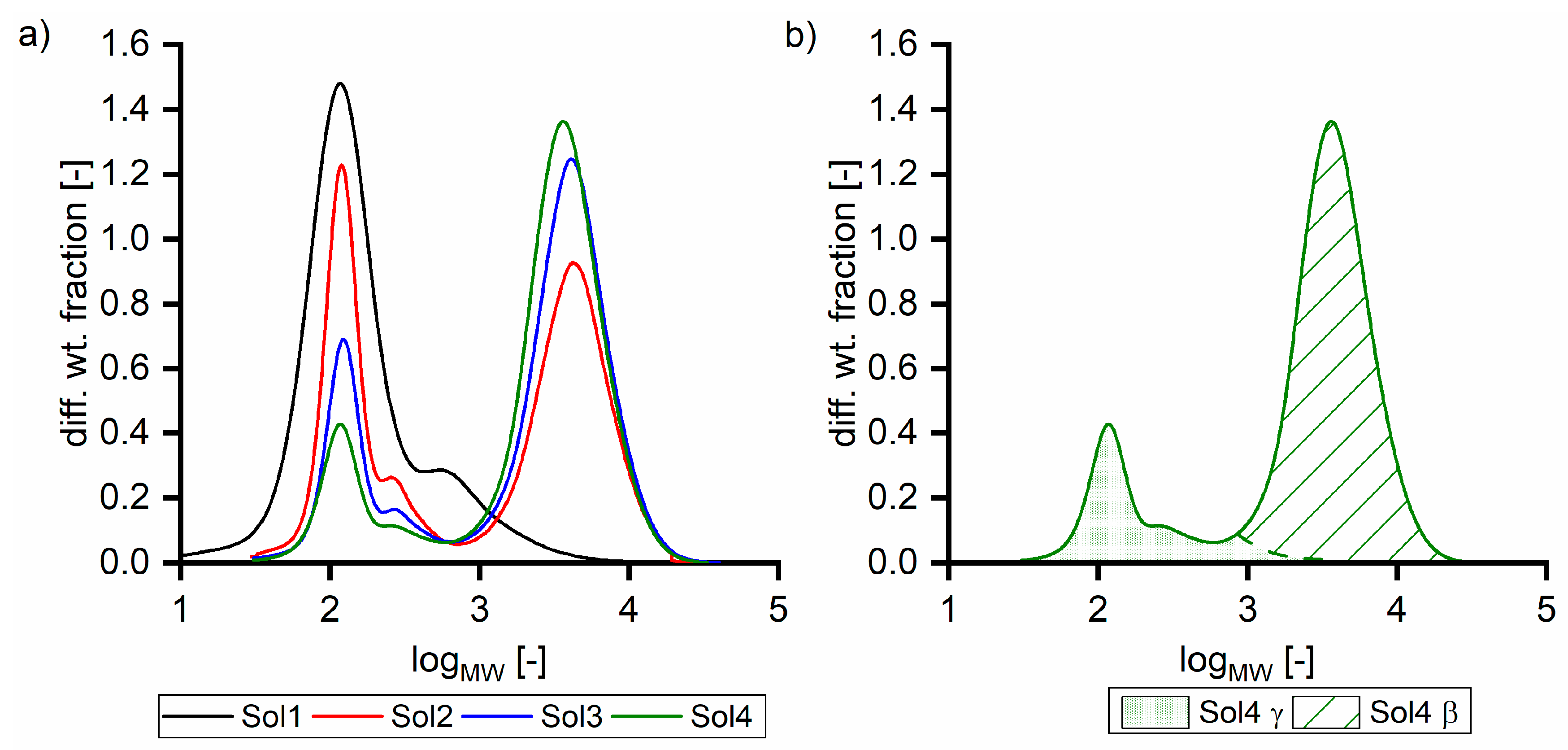
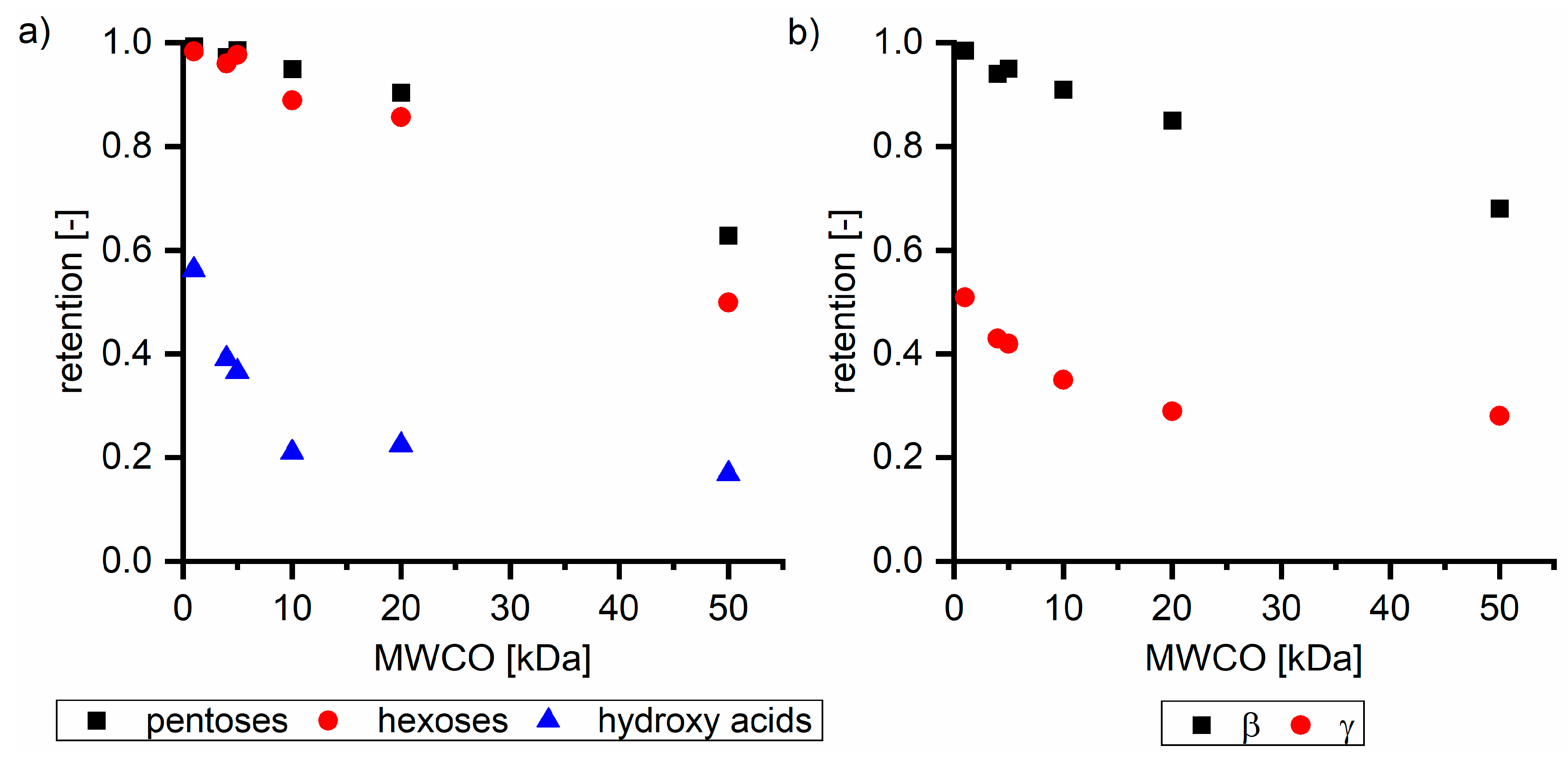
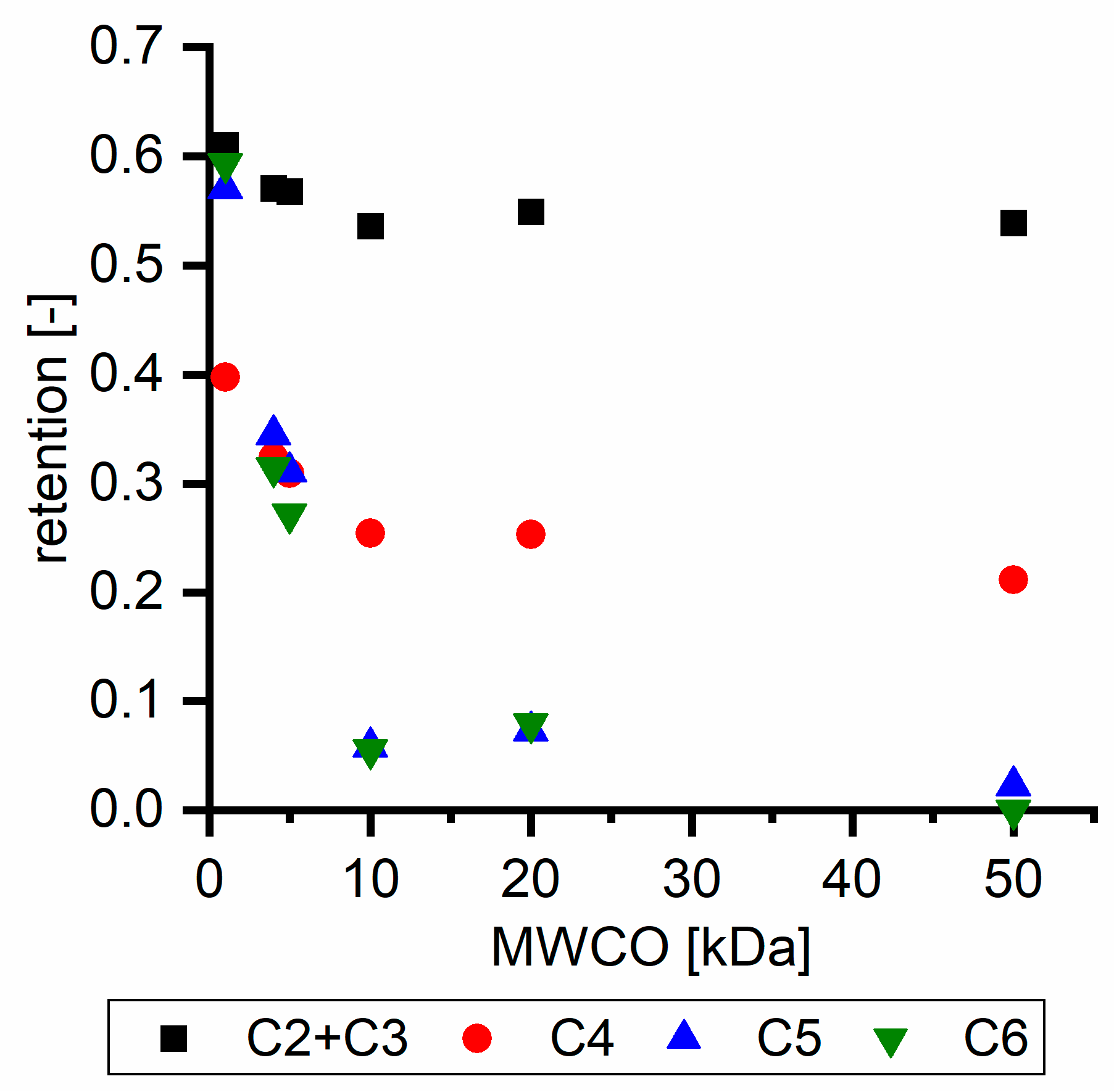
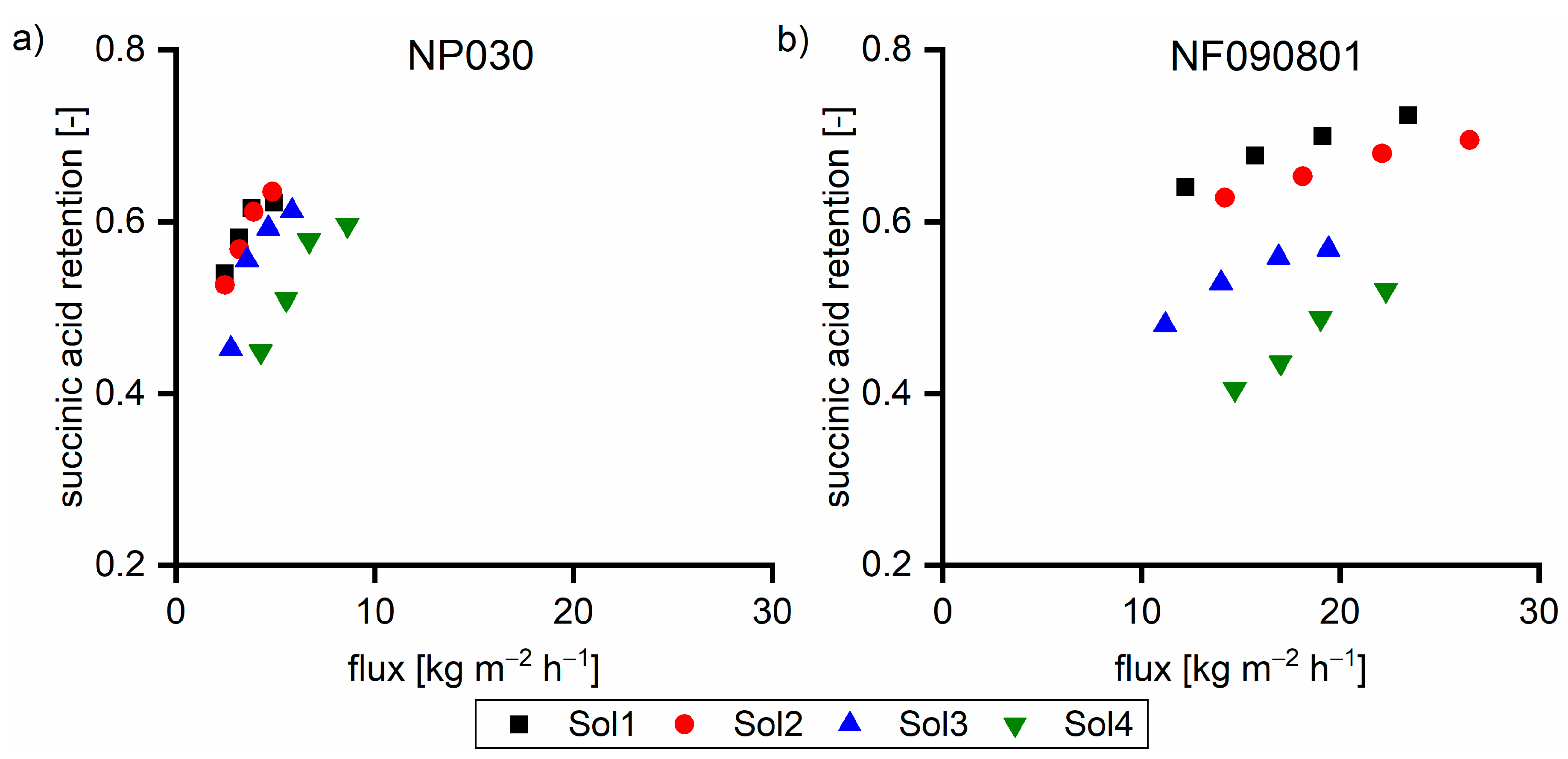
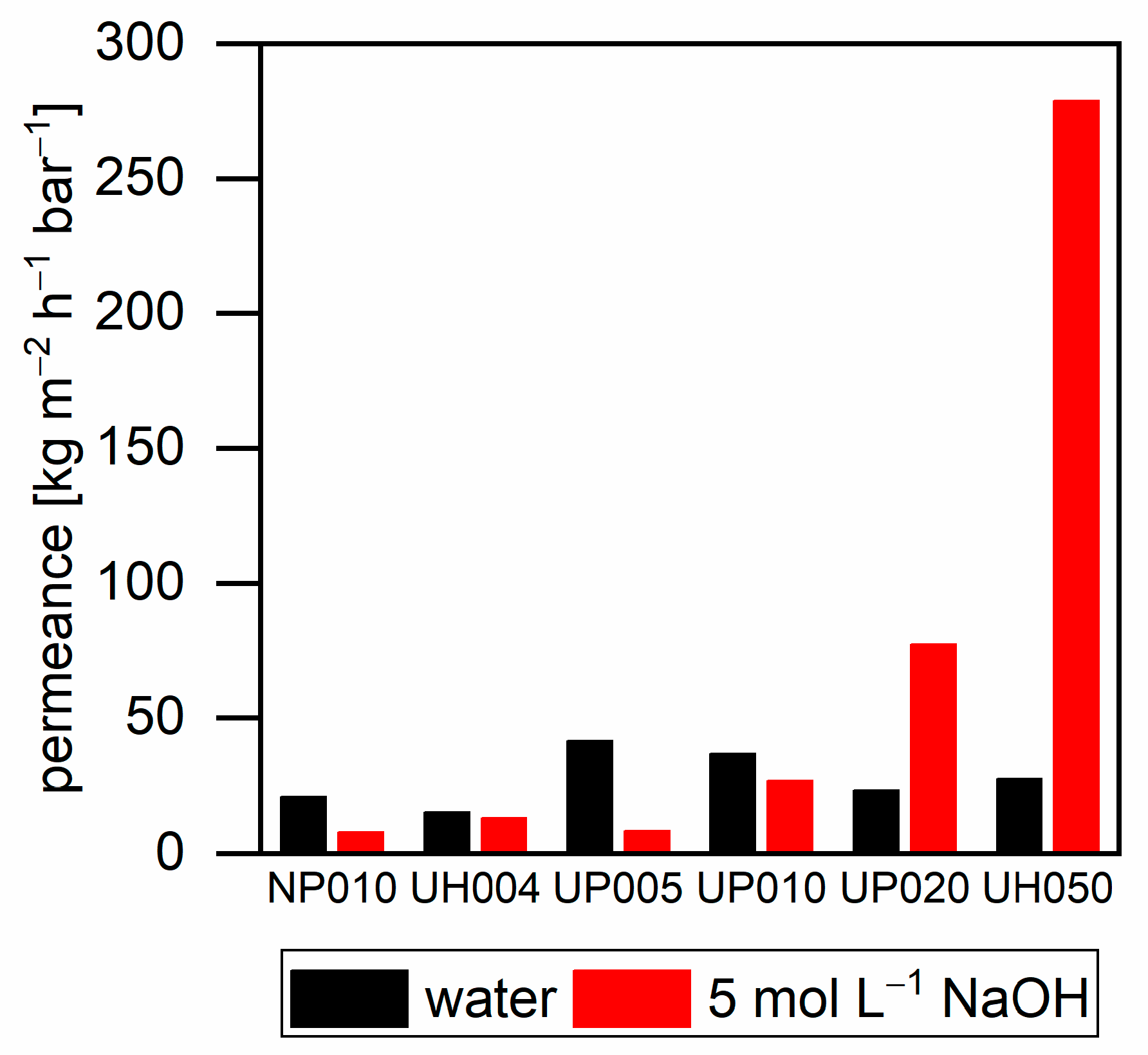
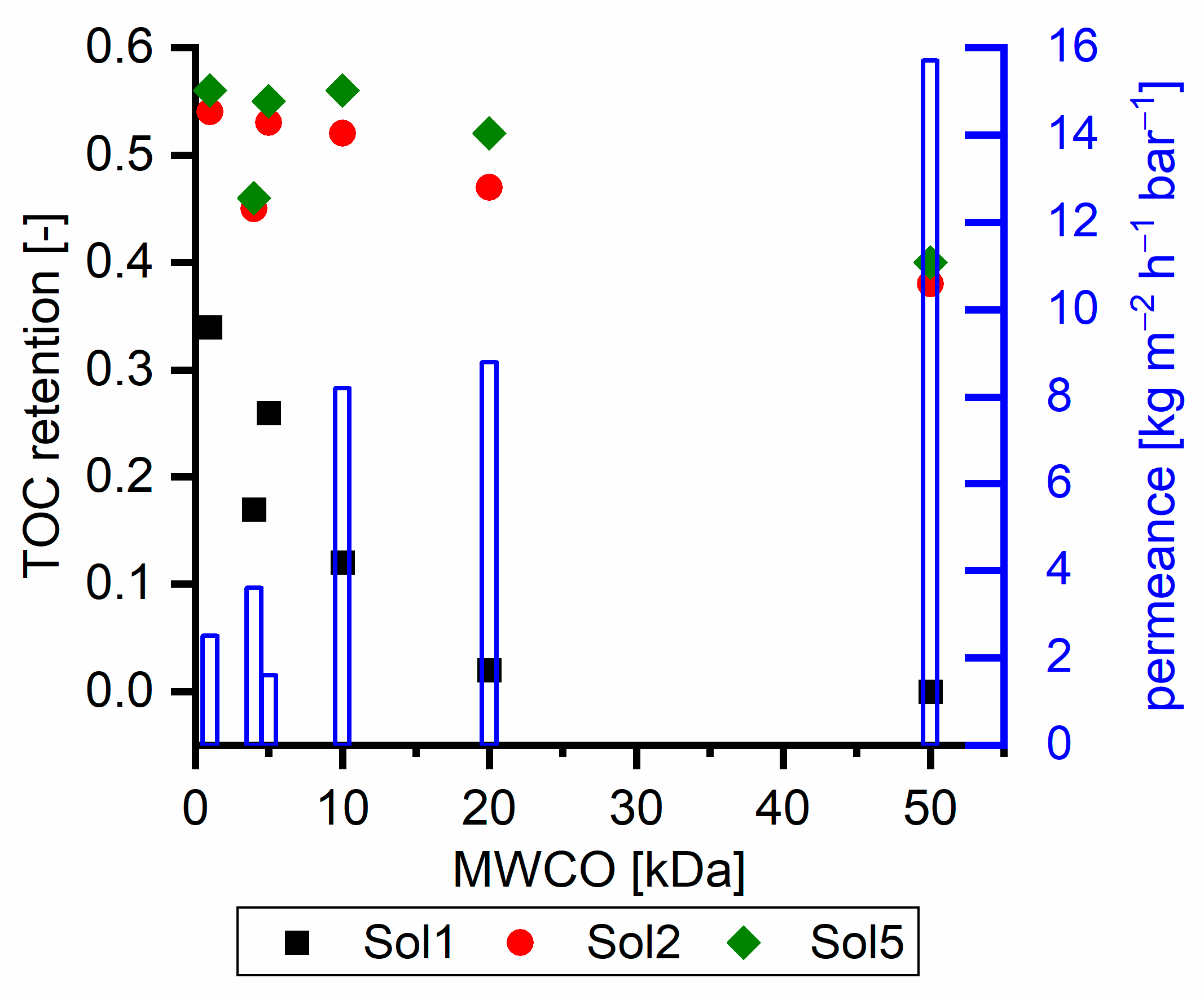
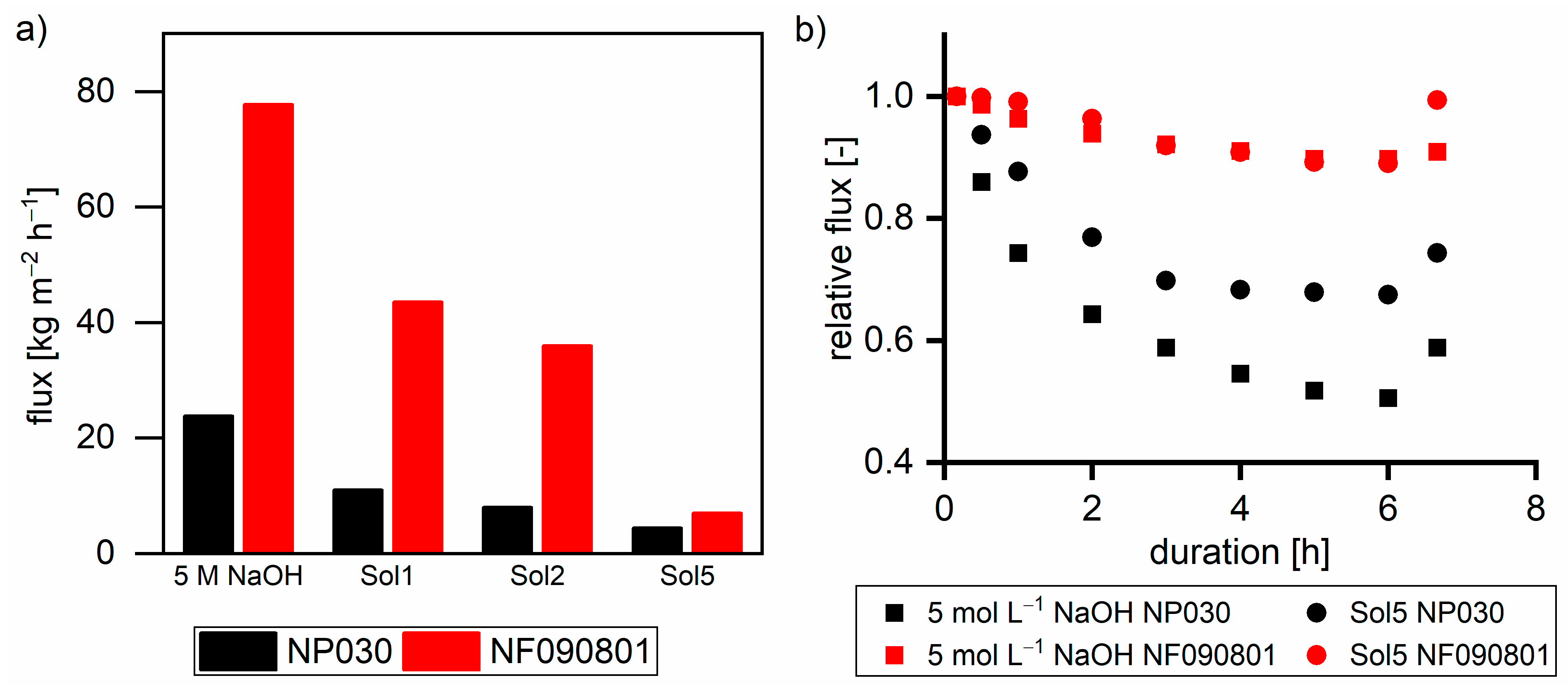

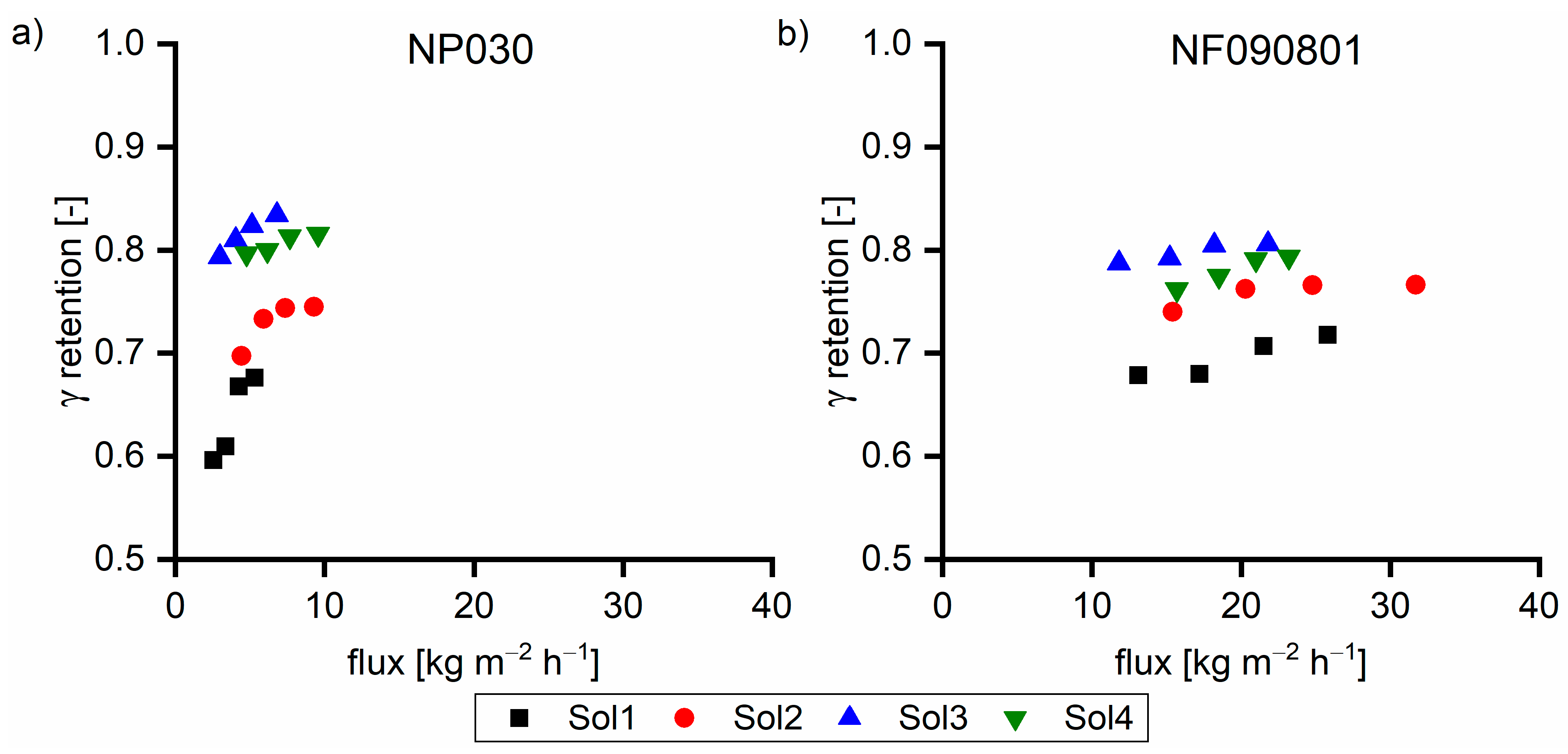
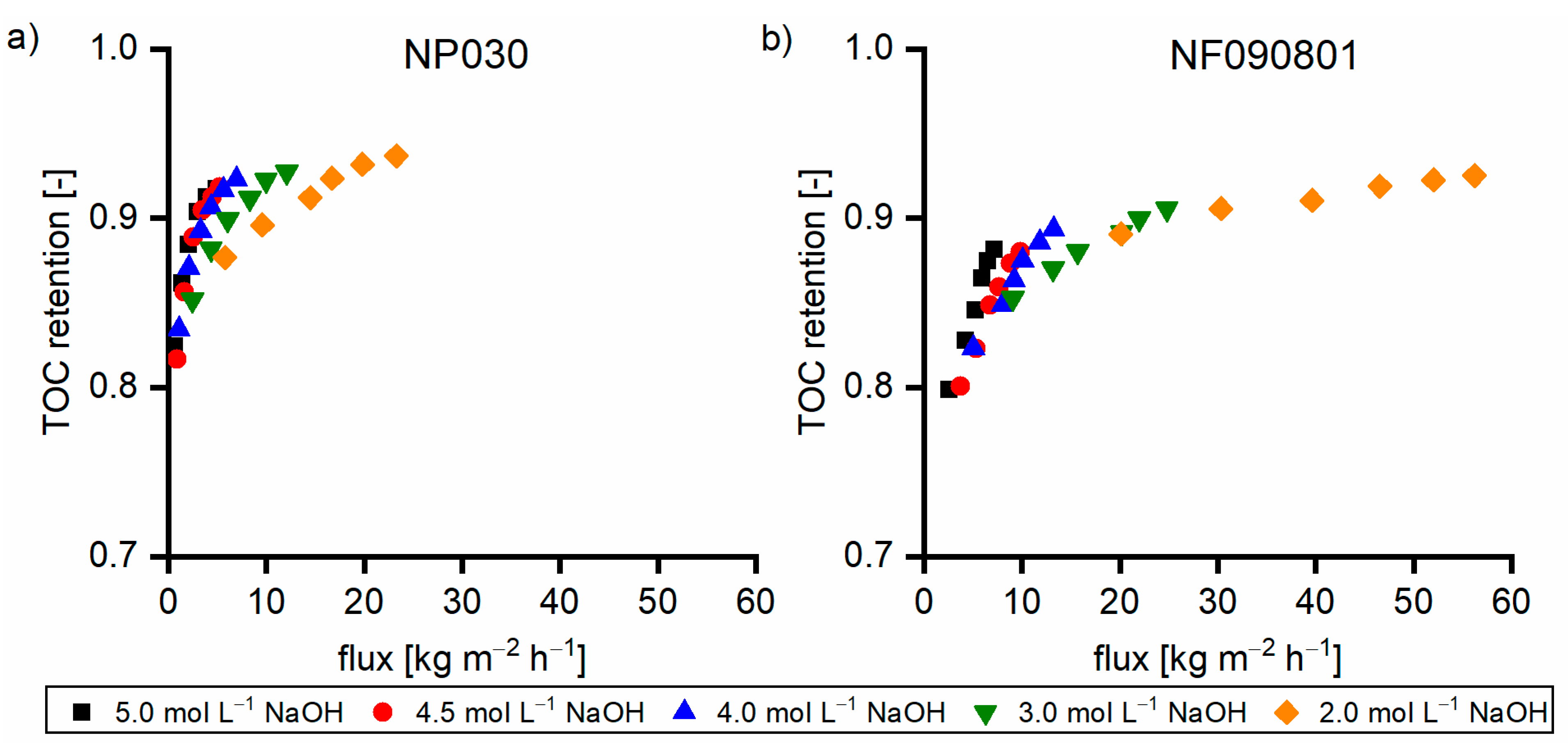
| Parameter | Sol1 | Sol2 | Sol3 | Sol4 | Sol5 |
|---|---|---|---|---|---|
| cNaOH [mol L−1] | 5 | 5 | 5 | 5 | 5 |
| TOC [g L−1] | 8 | 16 | 30 | 30 | 60 |
| β [%] | 0 | 25 | 39 | 45 | 45 |
| γ [%] | 100 | 75 | 61 | 55 | 55 |
| hexoses [g L−1] | 0 | 0.5 | 1.8 | 2.1 | 4.1 |
| pentoses [g L−1] | 0 | 8.2 | 27.6 | 31.8 | 63.5 |
| hydroxy acids * [g L−1] | 17.3 | 22.0 | 24.8 | 15.5 | 30.1 |
| Property | NP030 | NP010 | UH004 | UP005 | UP010 | UP020 | UH050 | NF09081 |
|---|---|---|---|---|---|---|---|---|
| Support material | PES | PES | PESH | PES | PES | PES | PESH | PET |
| Surface material | PES | PES | PESH | PES | PES | PES | PESH | SPEEK * |
| Maximum temperature [°C] | 95 | 95 | 95 | 95 | 95 | 95 | 95 | 80 |
| Recommended pH range | 0–14 | 0–14 | 0–14 | 0–14 | 0–14 | 0–14 | 0–14 | up to 14 |
| MWCO [g mol−1] | 30 ** | 10 *** | 4000 | 5000 | 10,000 | 20,000 | 50,000 | 50 ** |
| Water permeance [L m−2 h−1 bar−1] | 1 | 5 | 6.8 | 10.2 | 50.3 | 70.3 | 85 | 1–2 |
| MW [Da] | cFeed [mgTOC L−1] | Retention [−] | |||||||
|---|---|---|---|---|---|---|---|---|---|
| NP010 | UH004 | UP005 | UP010 | UP020 | UH050 | ||||
| glycolic acid | 76.1 |  | 469 | 0.54 | 0.60 | 0.64 | 0.51 | 0.52 | 0.51 |
| lactic acid | 90.1 |  | 1324 | 0.60 | 0.52 | 0.51 | 0.52 | 0.54 | 0.51 |
| 3-hydroxypropanoic acid | 90.1 |  | 197 | 0.64 | 0.63 | 0.57 | 0.47 | 0.48 | 0.46 |
| glycerol | 92.1 |  | 186 | 0.85 | 0.79 | 0.82 | 0.78 | 0.76 | 0.88 |
| hydroxyisobutyric acid | 104.1 |  | 160 | 0.26 | 0.27 | 0.10 | 0.01 | 0.05 | 0.02 |
| 4-hydroxybutanoic acid | 104.1 |  | 257 | 0.16 | 0.03 | −0.01 | 0.00 | 0.04 | 0.00 |
| 2,3-dihydroxy-2-methylpropanoic acid | 120.1 |  | 104 | 0.52 | 0.52 | 0.46 | 0.37 | 0.39 | 0.36 |
| malic acid | 135.1 |  | 86 | 0.51 | 0.71 | 0.79 | 0.77 | 0.84 | 0.80 |
| 2,4-dihydroxybutanoic acid | 120.1 |  | 263 | 0.74 | 0.71 | 0.68 | 0.61 | 0.62 | 0.59 |
| 3,4-dihydroxybutanoic acid | 120.1 |  | 354 | 0.32 | 0.13 | 0.20 | 0.12 | 0.05 | −0.01 |
| 4-hydroxy-pent-3-enoic acid | 116.1 |  | 203 | 0.29 | 0.25 | 0.16 | 0.01 | 0.03 | −0.01 |
| 2-hydroxypentanedionic acid | 148.1 |  | 283 | 0.31 | 0.34 | 0.28 | 0.27 | 0.35 | 0.22 |
| xyloisosaccharinic acid | 150.1 |  | 2030 | 0.64 | 0.36 | 0.33 | 0.02 | 0.03 | −0.01 |
| 3-deoxy-xylaric acid | 164.1 |  | 47 | 0.34 | 0.28 | 0.26 | 0.58 | 0.58 | 0.49 |
| glucoisosaccharinic acid | 180.2 |  | 2431 | 0.59 | 0.31 | 0.27 | 0.06 | 0.08 | −0.03 |
| Hydroxy acid retention | 0.56 | 0.39 | 0.37 | 0.21 | 0.22 | 0.17 | |||
| NP030 | NF090801 | |||||
|---|---|---|---|---|---|---|
| Sol1 | Sol2 | Sol4 | Sol1 | Sol2 | Sol4 | |
| C2+C3 | 0.54 | 0.75 | 0.72 | 0.61 | 0.77 | 0.72 |
| C4 | 0.58 | 0.49 | 0.20 | 0.58 | 0.62 | 0.28 |
| C5 | 0.73 | 0.75 | 0.55 | 0.77 | 0.69 | 0.45 |
| C6 | 0.69 | 0.68 | 0.54 | 0.73 | 0.68 | 0.61 |
| NaOH [mol L−1] | TOC [g L−1] | Permeance [kg m−2 h−1 bar−1] | |
|---|---|---|---|
| NP030 | NF090801 | ||
| 5.0 | 60 | 0.13 | 0.23 |
| 4.5 | 54 | 0.14 | 0.30 |
| 4.0 | 48 | 0.18 | 0.41 |
| 3.0 | 36 | 0.33 | 0.76 |
| 2.0 | 24 | 0.67 | 1.76 |
| 5.0 | 30 | 0.16 | 0.66 |
| 5.0 | 16 | 0.24 | 1.08 |
| 5.0 | 8 | 0.27 | 1.18 |
Publisher’s Note: MDPI stays neutral with regard to jurisdictional claims in published maps and institutional affiliations. |
© 2021 by the authors. Licensee MDPI, Basel, Switzerland. This article is an open access article distributed under the terms and conditions of the Creative Commons Attribution (CC BY) license (http://creativecommons.org/licenses/by/4.0/).
Share and Cite
Schlackl, K.; Herchl, R.; Almhofer, L.; Bischof, R.H.; Fackler, K.; Samhaber, W. Intermolecular Interactions in the Membrane Filtration of Highly Alkaline Steeping Lye. Membranes 2021, 11, 88. https://doi.org/10.3390/membranes11020088
Schlackl K, Herchl R, Almhofer L, Bischof RH, Fackler K, Samhaber W. Intermolecular Interactions in the Membrane Filtration of Highly Alkaline Steeping Lye. Membranes. 2021; 11(2):88. https://doi.org/10.3390/membranes11020088
Chicago/Turabian StyleSchlackl, Klaus, Richard Herchl, Lukas Almhofer, Robert H. Bischof, Karin Fackler, and Wolfgang Samhaber. 2021. "Intermolecular Interactions in the Membrane Filtration of Highly Alkaline Steeping Lye" Membranes 11, no. 2: 88. https://doi.org/10.3390/membranes11020088







